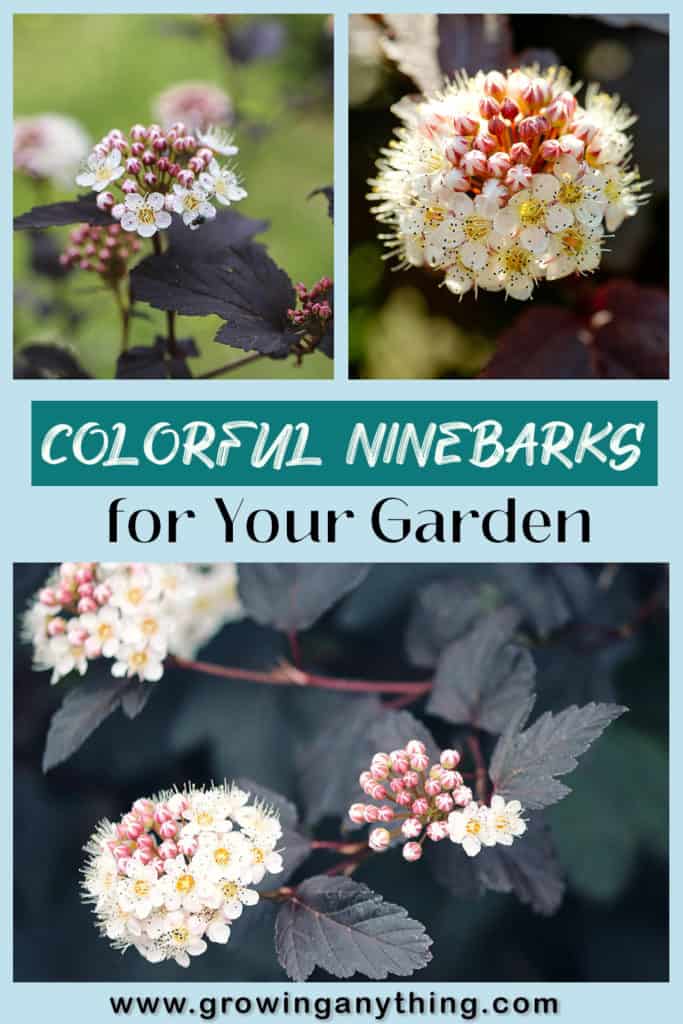11 Best Colorful Ninebarks
Colorful ninebark is just the plant that you need to make your garden more beautiful than any garden out there. This is a colorful and flowery deciduous shrub that is used in landscaping very often. It is called a ‘ninebark’ because of the bark that can be peeled into several layers, possibly even nine.
With a dark color to the leaves, this is a great shrub that flowers usually during the spring and maybe in early summer. In landscaping, this type of shrub is usually used for foundation and specimen planting, as well as screens and hedges. If you have problems with the land eroding in your yard, then you can also consider adding this shrub to keep prevent erosion.
The only thing that it needs is enough space and proper pruning. Aside from this, it is pretty low maintenance but still very good looking. You can even choose from the many color options to fit the shrub best in your private garden.
Ninebark Shrub Facts
The ninebark shrub might not seem like an outstanding option, but it will surely be a strong staple in your garden. Its botanical name is Physocarpus opulifolius and it is classified as a perennial deciduous shrub. It can grow more than ten feet tall and reach a wight of almost eight feet.
Some of its main characteristics include toughness and a strong ability to adapt to different climates. Also, it is reliable, durable, and as I mentioned previously it requires little to no maintenance.
The ninebark shrub has a very interesting form and foliage, while its flowers are just so colorful that you will immediately be mesmerized by them. It is quite hard to imagine a garden without at least one such shrub.
Why Should I Use Ninebarks for My Garden?
The reason why ninebark shrubs are so popular is because of their ability to create form and structure in just about any garden space. Recently, they have become a stand-out option thanks to their colorful options and low-maintenance. They are great for homeowners who want to make their gardens more beautiful but do not have the time to take that much care of them.
If you are looking to create some kind of barrier or hedge, this could be the perfect choice for you. Also, the shrub is used for edging beds. If you are looking for a smaller shrub, you can just take your clippers and trim the shrub to fit your needs best.
Another reason why ninebarks are used so often is that they are adaptable to different climates. You can raise them both in dry and wet areas without much difficulty. Once it gets established in your garden, the shrub will grow pretty quickly.
When it reaches the desired size, you will need to learn how to properly trim it and water it. But until that time comes, you can let it grow on its own and become the focal point of your garden. It will certainly make an emptier garden seem better in just a few weeks!
Known for being almost completely indestructible, the ninebark shrub is just the plant that you need in your garden!

Basic Characteristics of a Ninebark
A common type of ninebark is different from other variations. This is a tall shrub with branches that can extend and become almost eight feet tall and six feet wide. When in ideal conditions, the brush can become as tall as twelve feet.
From the stem upwards, the sprouts give this shrub an interesting, fountain-like form. However, if the shrub is not properly and timely trimmed, it can become a bit too invasive. So, it is very important to take care of the multiple layers of bark that this shrub has.
When it comes to the leaves of the shrub, they resemble a maple leaf. Anywhere from one to five inches long, the leaves are rounded with one larger and two smaller lobes. The surface of the leaves is somewhat glossy and tough.
Usually, the flowering of the shrub takes place in late spring or early summer. The small flowers that are a part of this shrub are very attractive and can be of various colors – from white to pink or even yellow.
Ideal Growing Conditions for Ninebarks
One of the main characteristics of ninebarks is its ability to adapt to any kind of climate or region. It might face some struggles when in too hot or too humid places, but it will rarely completely die out. The drier climate seems to fit it best, as seen in various research projects.
The shrub can grow in both sunny and shady areas, but it does not like bright full shade. As for the soil, it can tolerate all types of soil including sand, construction debris, and even clay and loam. Researchers have found that it will also grow easily in rocky or gravel soil, as well as dry and wet soil.
This is truly one of the toughest plants out there, but also one of the most low-maintenance shrubs!
How to Plant a Ninebark?
If you are planning of adding a ninebark shrub to your garden, then you will need a larger free area for it. If the shrub comes in a pot, when digging a hole for it in your garden, you should make the pot at least three times bigger than the size of the pot itself.
Make sure that the soil has enough organic material and give it a lot of water when you first plant it. When the shrub gets established, you will need to water it once a week at the most. This could vary, as people who live in hotter areas will need to water the ninebark more often.
An established plant rarely suffers from drought, but make sure that you give it enough water during the dry periods. It will help it maintain a glowing and attractive look.
How to Care for a Ninebark?
There is not a lot to discuss when it comes to taking care of a ninebark shrub. As I have already mentioned, it pretty much takes care of itself. Giving it some fertilizer and enough water will improve its look and growth but it can also leave without fertilizer and with little water.
Probably the most important thing about the ninebark is the proper pruning. I have already said that the shrub can get pretty wild and big when not trimmed, so you will need to take care of the branches every so often.
The main stems should be shortened every now or then, and you can also remove all old branches. This will help make room for new branches and give the plant life. Once you give the shrub a trim, it will not take long for it to re-sprout again.
Another thing that I would mention about the ninebark is that it does not attract pests and it is not likely to contract diseases. With this plant, you will not have to worry about anything more than trimming and watering it.
Colorful Ninebarks
Colorful ninebarks will make you enjoy your garden! But before you decide just which type of ninebark is best for your garden, allow me to tell you more about each type of this plant that exists!
Pacific Ninebark
- Flower Color: White flowers
- Soil Type: All kinds of soil
- Bloom Season: Spring
- Height: Up to 18 feet
- Hardiness: Very hardy
Asian Ninebark
- Flower Color: White flowers
- Soil Type: All kinds of soil
- Bloom Season: Spring
- Height: Up to 18 feet
- Hardiness: Very hardy
Mallow Ninebark
- Flower Color: White flowers
- Soil Type: Drier soil
- Bloom Season: Spring
- Height: Up to 7 feet
- Hardiness: Very hardy
Mountain Ninebark
- Flower Color: White, Red Brown
- Soil Type: Rocky soil
- Bloom Season: Spring
- Height: Up to 4 feet
- Hardiness: Very hardy
Common Ninebark
- Flower Color: White flowers
- Soil Type: Moist, acidic soil
- Bloom Season: Late spring
- Height: Up to 10 feet
- Hardiness: Very hardy
Amber Jubilee
- Flower Color: White, pink flowers
- Soil Type: Well-drained soil
- Bloom Season: Spring
- Height: Up to 7 feet
- Hardiness: Very hardy
Dart’s Gold
- Flower Color: White flowers
- Soil Type: All kinds of soil
- Bloom Season: Spring
- Height: Up to 5 feet
- Hardiness: Very hardy
Diablo
- Flower Color: White and pinkish-white flowers
- Soil Type: Well-drained soil
- Bloom Season: Late spring and early summer
- Height: Up to 10 feet
- Hardiness: Very hardy
Lady in Red
- Flower Color: White and pink flowers
- Soil Type: All kinds of soil
- Bloom Season: Spring
- Height: Up to 6 feet
- Hardiness: Very hardy
Little Devil
- Flower Color: White and pink flowers
- Soil Type: Sandy, acidic soil
- Bloom Season: Spring
- Height: Up to 4 feet
- Hardiness: Very hardy
Summer Wine
- Flower Color: Pink
- Soil Type: Well-drained soil
- Bloom Season: Spring
- Height: Up to 6 feet
- Hardiness: Very hardy
11 Colorful Ninebarks You Should Plant In Your Garden
As a shrub that is part of the large rose family, the ninebark has several varieties that we should mention. It has been said that this type of plant has seven different species and several sub-species. Here are the names and characteristics of all known types of ninebarks:
1. Pacific Ninebark – Physocarpus Capitatus
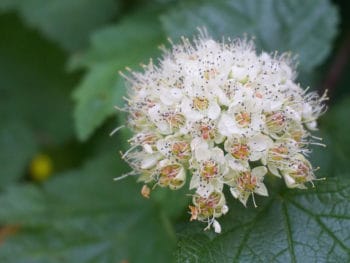
Pacific ninebark was first discovered in Southeast Alaska. It also grows in California and some parts of British Columbia. This type of ninebark shrub is more often found in places with low elevation.
The Pacific ninebark can grow up to eighteen feet in ideal circumstances. However, it is known for being a bit short-lived. It likes areas that are a bit moister but it can also be found in drylands.
One of the characteristics of this type of ninebark shrub is its brown bark that shreds easily. It has toothed leaves and small white flowers. When it comes to fruit, it is known to grow small red follicles.
Watch this video to know more:
2. Asian Ninebark – Physocarpus Amurensis
Another type of deciduous ninebark shrub, the Asian ninebark can grow up to eight feet tall and 3 feet wide. It is most commonly grown in Korea, China, and even Russia. However, it can also be found in Alaska.
The leaves on this type of ninebark shrub are much different than the ones found on the shrubs grown in America. Rarely is this type of shrub found in gardens in America, probably because the other types are more popular in the country.
3. Mallow Ninebark – Physocarpus Malvaceus
A type of ninebark shrub that can grow up to seven feet tall. The leaves can be of different size and shape, usually, they are smaller with round or broad lobes. Their color is dark green and pubescent.
During the summertime is when it gets its flowers which are usually white. The shrub likes sunny regions and does not develop well in full shade. You can find this type of shrub in gardens around British Columbia, Washington, Oregon, Utah, Nevada, and Idaho.
Watch this video to know more:
4. Mountain Ninebark – Physocarpus Monogynus
The mountain ninebark is also known as low ninebark because it does not grow very tall. It can only reach a height of four feet. The leaves on this type of ninebark shrub are usually dull green with some lobes on them.
When it comes to the bark of the shrub, it is usually brownish and it can have several layers. The shrub gets its first flowers in late spring and they are usually white or rose.
An interesting fact about this type of ninebark is that Indians used to make a poultice from its roots that is known to help relieve pain.
Watch this video to know more:
5. Common Ninebark – Physocarpus Opulifolius
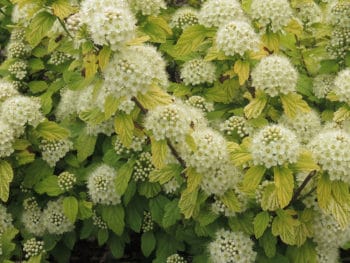
The common ninebark shrub can grow up to ten feet and it can become ten feet wide. So, if you are planning on using this type of shrub in your garden, you better be prepared to give it a lot of space.
It can grow in dry and moist areas, in all kinds of soil. As for sun exposure, it can tolerate full sunlight or partial shade. This type of ninebark is usually found in eastern North America.
Probably the best thing about it is its perfect flowers. They are called perfect because they have both male and female parts, so they are self-infertile. The flowers are gorgeous, with red or pink color.
This type of shrub is beneficial for birds, all types of insects but especially bees. As you might know, the bees are frequent pollinators of this type of shrub.
Watch this video to know more:
6. Amber Jubilee – Jefam
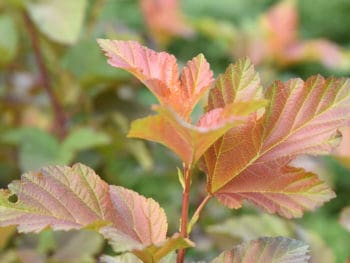
Initially created in Manitoba, this type of ninebark shrub is now very popular because of its gorgeous colors and great characteristics. Its bold shrub has undertones of gold, yellow, and orange that makes it stand out amongst other shrubs. At the same time, its flowers are white and amazing.
The Amber Jubilee can reach a height of seven feet and a width of six feet. It is best to plant it in full sun if you want to get the most out of it. This is a great plant because it is very tough and resistant, while also very reliable.
Watch this video to know more:
7. Dart’s Gold
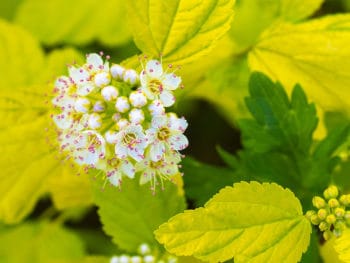
This type of ninebark shrub got its name after the broad golden foliage with three lobes. The shrub’s leaves are lime green, while the flowers are usually pink-dusted and white.
The shrub should be put in full sun or light shade, it will not grow quickly if put in full shade. One of the best things about this shrub is the fact that it stays gorgeous even during the winter.
Again, this type of ninebark is long-lasting and very tough. It can tolerate all kinds of weather and all types of soil. However, it grows best in moderately moist soil.
8. Diablo – Monlo
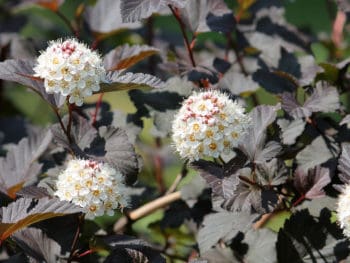
An upright shrub with amazing flowers, the Diablo ninebark will leave you speechless with its beautiful colors. The foliage is a bit darker, while the flowers are bright yellow and at times greenish.
This ninebark shrub like the sun and grows best in moist but well-drained soil that is rich with fertilizer and also acidic. It can grow up to ten feet in height and width. It does not require much maintenance, just like the other types of ninebarks.
Watch this video to know more:
9. Lady in Red
Even from the name, anyone could guess the color of the leaves of this type of ninebark shrub. It is the perfect choice both for the garden or in-home plants. The leaves are bright red, while the flowers are pink and white.
The best growing conditions for this type of shrub include moist soil that has good drainage and that is slightly acidic. It also needs regular pruning to encourage new flowers to grow. The maximum height that it can reach is six feet.
Watch this video to know more:
10. Little Devil – Donna May
This is almost like a dwarf version of the ninebark shrub because it does not grow nearly as big as the other types of ninebark. What makes it special is the interesting leaves that have a coral pink to rich-chocolate purple color. As for the flowers, they are white with pink overtones.
The height of this shrub can reach only four feet, while the wight is only three feet tops. Even though it does not grow that quickly, it is quite long-lasting and it can live up to three decades.
The shrub is extremely tough, beautiful, and can be used in all kinds of weather.
Watch this video to know more:
11. Summer Wine – Seward
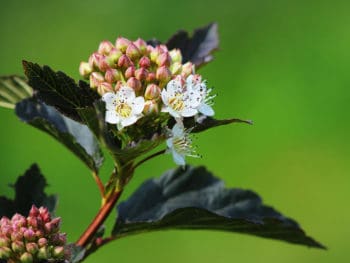
Very easy to care for and sophisticated type of shrub, the Summer Wine ninebark is a great choice for anyone’s gardens. The color of the leaves is deep purple, while the flowers are light pink.
This type of ninebark requires a lot of sunlight and does not grow well in full shade. It is best if you water it every day and if you keep its soil fertilized at all times. Also, you can do some pruning to it if you want to encourage the growth of new leaves and flowers.
The maximum height of this plant is six feet, and the same goes for its wight. Another thing that you should know before you plant it in your garden is that it should be planted at least five feet away from all other plants.
Watch this video to know more:
Conclusion
You can never go wrong with a ninebark shrub. All of the above-mentioned types are very durable, very tough, and do not require a lot of maintenance. They are not only easy to take care of, but they are also gorgeous.
The ninebark shrub can be a great addition to anyone’s garden. Go over my list of the varieties of ninebark and find out which one would fit your garden best. Let me know in the comments if you know of any other varieties that I should mention and share your thoughts about them!
